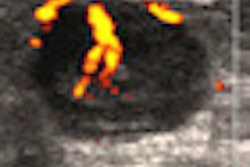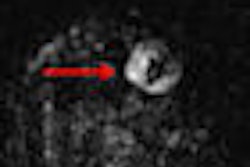For women between the ages of 40 and 49 who are at high risk for breast cancer, the benefits of mammography screening every other year outweigh the potential harms, according to a new study published in the May 1 issue of Annals of Internal Medicine.
However, the researchers from Georgetown's Lombardi Comprehensive Cancer Center also found that the balance of benefits and potential harms in this same group is not favorable when the frequency of mammography screening is increased to once a year. They also found that women experience greater harms from screening with digital mammography compared to film mammography (Ann Int Med, May 2012, Vol. 156:9, pp. 609-617). The study was funded by the U.S. National Cancer Institute (NCI).
"Our research suggests the benefit-harm balance is tipped in favor of every-other-year screening for women in their 40s who are at about twice the average risk of developing breast cancer," said study senior author Dr. Jeanne Mandelblatt.
The new study supports screening guidelines published in 2009 by the U.S. Preventive Services Task Force (USPSTF), which recommended mammography screening every other year for women ages 50 to 74 who have an average risk of developing the disease. The USPSTF did also state, though, that the decision to start regular, biennial screening mammography before the age of 50 should be an individual one that takes into account a woman's values and risk factors.
"We conducted this study to address the gap in knowledge and information that exists for women and providers for determining when to begin screening," Mandelblatt told AuntMinnie.com. "It's important for women to understand that while mammography is a good test, and the best we have, it's not a perfect test. It's associated with certain harms. Modeling provides us a powerful tool to estimate the balance between the benefits and harms of mammography for groups of women, but it doesn't tell individual women what they should do."
The USPSTF's guidelines were based in part on earlier research conducted by Mandelblatt and her colleagues, according to a statement released by Georgetown University Medical Center.
"The absolute benefits (for example, number of deaths prevented) are smaller [for women younger than 50] than for older women because of the lower incidence of breast cancer and lower sensitivity of mammography in women aged 40 to 49 years," Mandelblatt's team wrote. "At the same time, screening in this age group is accompanied by more harm (false-positive results and unnecessary biopsies) as a result of lower screening specificity."
Mandelblatt's group characterized benefits of screening as life-years gained and breast cancer deaths averted. Harms were defined as false positives. Conditions that suggested a twofold increase in risk included having extremely dense breasts (13% of the population ages 40 to 49) or having a first-degree relative with breast cancer (9% of the population ages 40 to 49).
The study incorporated four microsimulation models that were developed as part of the Cancer Intervention and Surveillance Modeling Network (CISNET). Models were based on assumptions used for the 2009 USPSTF recommendations. Study data were gleaned from three national research groups: the Breast Cancer Surveillance Consortium (BCSC), CISNET, and the Oregon Evidence-Based Practice Center.
"We estimated the effect of each screening strategy on the number of breast cancer cases detected, the number of breast cancer deaths averted, the number of life-years gained, and the number of false-positive results on mammography screening," the group wrote.
The models estimated that without screening mammography, a median of 153 cases of breast cancer would be diagnosed and 25 deaths from breast cancer would occur among 1,000 women 40 years of age followed over their lifetimes. If these women had biennial film mammography between the ages of 50 and 74 years, the models showed that a median of 10,610 mammograms would be taken over 12.5 screening rounds, 6.3 breast cancer deaths would be avoided, 109 life-years would be gained, and 883 mammography results would be read as false positive. Harm-benefit ratios were estimated at 8.3 false-positive findings per life-years gained and 146 false-positive findings per deaths averted.
Digital mammography screening showed more life-years gained and more breast cancer deaths averted than film-screen mammography, but "because of the lower specificity of digital mammography for women in their 40s, it also yields more false-positive results," the researchers wrote. This lead them to conclude that in all four models there is greater harm relative to benefit from digital than film-screen mammography in women younger than 50. Women would need to have at least a fourfold increase in risk of developing breast cancer to start screening at age 40 using digital mammography and still have the same balance of benefits and harms as average-risk women ages 50 to 74, according to the team.
"The reason we keep coming back to this question [of when to start mammography screening] over and over and over again is because mammography is an imperfect test," Mandelblatt told AuntMinnie.com. "The ideal test would distinguish which small tumors are lethal and which are harmless, and would find only real tumors and not false positives. So that's a challenge, and it's where we should be focusing our efforts, not at what age a woman should start screening."
What boosts risk?
In a related meta-analysis published along with Mandelblatt's study, Dr. Heidi Nelson, of Oregon Health and Science University, and colleagues aimed to determine which factors increase risk for breast cancer in women ages 40 to 49 years and the magnitude of risk for each factor. They used data from Medline (January 1996 to November 2011), the Cochrane Central Register of Controlled Trials and Cochrane Database of Systematic Reviews (fourth quarter of 2011), Scopus, and the Breast Cancer Surveillance Consortium (Ann Int Med, May 2012, Vol. 156:9, pp. 635-648). Mandelblatt also co-authored this NCI-funded analysis.
Sixty-six studies were included in the review. The researchers found that women in their 40s with extremely dense breasts on mammography or at least one first-degree relative with breast cancer had at least a twofold increased risk for breast cancer. This level of risk corresponds to the risk threshold of the CISNET models (which demonstrated similar benefits and harms for increased-risk women starting biennial screening at age 40 years and average-risk women starting at age 50).
Skewed public perception?
In an accompanying editorial, Dr. Otis Brawley, chief medical officer and executive vice president of the American Cancer Society, cautioned that although mammography is a lifesaving technology that should be used, many overestimate its role in the decrease in breast cancer death rates. In fact, Brawley wrote, the positive effects of nonmammographic early detection through breast awareness and improvements in treatment "are substantial and account for at least half of the decrease in mortality if not most."
"I worry that the public perceives mammography as a better technology than it actually is," Brawley wrote. "Mammography screening is often promoted for its benefit. Unfortunately, many do not appreciate its limitations. Truth be told, it cannot avert all or even most breast cancer deaths. There are also trade-offs. Mammography, like every screening test, has a potential for harm, and one must carefully weigh the harm-benefit ratio for a specific woman or a specific population of women (such as those aged 40 to 49 years) before advising use of the test."




















